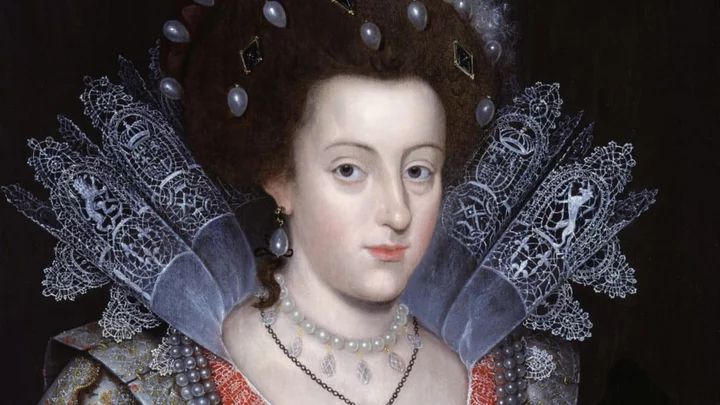Elizabeth Stuart was that rare thing—royal, intelligent, beautiful, and happy; subject to an arranged marriage, but with a man she truly loved. As one half of Continental Europe’s leading young Protestant couple, she had a star quality and seemed destined for greatness. Yet her reign only lasted one year.
Elizabeth spent more than 40 years in exile. Despite her fall into relative obscurity, all British monarchs since 1714 are linked back to her. How did her own path deviate so far from the fairy tale?
The Daughter of the King Who United the Crowns
Born in 1596 at Dunfermline Palace, Elizabeth was the daughter of King James VI of Scotland (later to unite the crowns as James I of England and Ireland) and Queen Anne of Denmark; granddaughter of Mary, Queen of Scots; and namesake of Queen Elizabeth I, who also was her distant cousin and godmother. Of her seven siblings, only she, her older brother Henry, and younger brother Charles survived infancy.
Elizabeth spent her early years at Linlithgow Palace, near Edinburgh, under the care of Lord Livingston. The young Elizabeth and her family moved to England when Queen Elizabeth I died in 1603 and James inherited the English crown.
By all accounts, she had an idyllic childhood. Elizabeth was sent to live with Lord and Lady Harrington at Coombe Abbey in Warwickshire. The Harringtons indulged her love of nature: They constructed several buildings on their estate containing paintings and stuffed animals in addition to an aviary and menagerie, complete with a selection of miniature cattle from around the British Isles. Elizabeth referred to this as her “fairy farm.”
She received the finest education in religion, humanities, modern languages, dancing, and music, missing only classics—which, in her father’s opinion, “had the unfortunate effect of making women more cunning.” She was fluent in French and Italian.
Her time at Coombe Abbey was good, but not long. Elizabeth was relocated to Kew—closer to the royal court—after an attempt to abduct her as part of the Gunpowder Plot was uncovered in 1605.
A Valentine Wedding
After the religious tension of Elizabeth I’s reign and the turmoil of his mother, Mary, Queen of Scott’s life, James saw himself as a peacemaker. His children’s marriages were a means to fulfil his political ambitions. With her high standing and renowned beauty, Elizabeth received potential suitors from across Europe, from which James chose Frederick V, Elector Palatine of the Rhine. (Had he chosen differently, Elizabeth may have become Queen of Sweden or Spain.) Frederick’s father had founded the Protestant Union, and James, a staunch Protestant, was particularly keen on strengthening Protestant links in Europe. On Frederick’s side, the match was favorable to elevate the Palatinate on the international stage.
Frederick arrived on October 16, 1612. Contemporary accounts detail how he was struck by Elizabeth from the start. Charming, handsome and athletic, at 16, Frederick was the same age as Elizabeth. Despite the arranged nature of their marriage, their love appeared genuine. Later, when Frederick was away on military campaigns, the couple corresponded several times a week, with Frederick describing Elizabeth as his “only heart."
Elizabeth was devastated when her beloved brother Henry died of typhoid less than a month after Frederick’s arrival. Public grief at losing the charismatic heir apparent was widespread; Elizabeth and Frederick’s lavish wedding on Valentine’s Day in 1613 provided a much-needed cause for celebration among the sadness. Poems and plays were written, and public festivities—including fireworks and a staged naval battle—delighted the people. The celebrations lasted two months before the newlyweds departed for Heidelberg, the capital of the Lower Palatinate, of which Elizabeth was now Electress.
The “Winter Queen” of Bohemia
Elizabeth and Frederick spent six years living in Heidelberg, where they had three children. In 1619, Bohemian Protestant nobles, revolting against the Catholic Holy Roman Empire, offered their crown to Frederick. Others had already declined, fearing the wrath of the new Holy Roman Emperor, Ferdinand II, but Elizabeth appealed to Frederick’s honor. She convinced him to accept.
The family moved to Prague, where Frederick was crowned on November 4, 1619; Elizabeth was crowned Queen of Bohemia three days later. In December, their fourth child, Prince Rupert, was born, an occasion of much rejoicing and richly symbolic of a new start.
But it would not stay good for long. The two were given the derisive moniker “Winter King and Queen” by contemporaries who expected them to reign for only a season before being ousted—and indeed, the couple experienced only one winter in Prague. Disaster struck on November 8, 1620, when Frederick’s army was defeated by Imperial forces at the Battle of White Mountain. The portentous sobriquet was to stick.
A “Queen of Hearts” in Exile
Elizabeth gave birth to the couple’s fifth child near Berlin after retreating from Prague. Heidelberg was occupied by the Catholic League, so the family fled to The Hague, under the invitation of Frederick’s uncle, Prince Maurice of Orange. They established a court in exile, partially funded by Elizabeth’s brother, now King Charles I. In 1623, Ferdinand II stripped them of the Palatinate.
While Frederick was occupied with military campaigns—returning often enough to father eight more children—Elizabeth tirelessly campaigned to promote Protestantism and regain her family’s fortunes from their court-in-exile. Nadine Akkerman, in her three volumes of The Complete Correspondence of Elizabeth Stuart, Queen of Bohemia, details the vast network of European elites with whom Elizabeth communicated, highlighting her influence in cultural, religious, and political spheres. In addition to writing thousands of letters, she commissioned miniatures to send to supporters, lest her family’s cause be forgotten. Her courage, loyalty, and devotion to the Protestant cause earned her the title “Queen of Hearts.”
Heartbreak eventually came for the Queen of Hearts. Frederick was struck with a prolonged illness during his return from a military campaign with the King of Sweden; he died in Mainz in November 1632, before reaching home. Elizabeth was inconsolable. For three days she neither ate, drank, nor slept. She mourned him for the rest of her life, covering her rooms in black and reserving certain days for fasting in his memory.
The 30 years Elizabeth lived after Frederick’s death were beset with tragedy. Having already lost three children, she was to lose a further four. She had refused her brother Charles I’s offer to return to England, resolving to fight for her son Charles Louis’s restoration to the Palatinate. Yet when this finally happened, via the Peace of Westphalia in 1648, Charles Louis did not allow Elizabeth to accompany him; the distance wrought on their relationship though years of her political campaigning had taken their toll. As a further blow, she endured her brother’s execution at the hands of Oliver Cromwell.
In 1650, Dutch financial support ceased. British financial support followed suit due to the English Civil War, leaving her in relative poverty. Elizabeth finally returned to England in 1661 after the Restoration saw her nephew crowned King Charles II.
She died from pneumonia on February 13, 1662, her fame a distant shadow and with no homeland to truly call her own. Her funeral took place with little pomp and Prince Rupert her only son in attendance. Her remains are interred in Westminster Abbey, in the same vault as her brother Henry and son Rupert.
Elizabeth Stuart’s Living Legacy
In 1701, the British Government passed the Act of Settlement, securing a Protestant succession and removing the Jacobite claim in one fell swoop. The heir presumptive became Elizabeth’s daughter, Sophia, Electress of Hanover.
Sophia died shortly before Queen Anne in 1714, and the throne passed to Sophia’s son, George, Elector of Hanover. As George I, he was the first Hanoverian monarch of Britain.
While history’s lens has often cast Elizabeth as the victim in the story of her life, or relegated her to the wings as the ill-fated monarch who ruled for only one year, in her lifetime she was an active political and cultural agent. She was Electress Palatine of the Rhine and Queen of Bohemia, and through her grandson, the founder of a new British ruling dynasty. As such, every British king or queen since George I is a direct descendent of the Winter Queen.
This article was originally published on www.mentalfloss.com as The Lasting Legacy of Elizabeth Stuart, the ‘Winter Queen’ of Bohemia.









